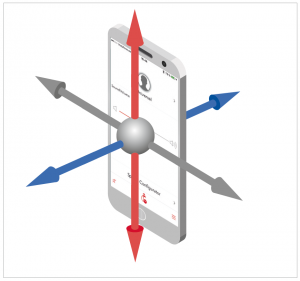Motion Detection. A System for the Listener on the Move.
Erik Harry Høydal
Introduction
Even just a few years ago we could not have imagined how intelligent our smartphones would become. Today, they continuously collect a great amount of information from our environment, including how we move about in our environment. Similarly, our hearing aids have also become increasingly sophisticated in just a few years. In terms of speech intelligibility in difficult listening situations we’ve even bypassed normal hearing (1,2), and listening eff ort could also be reduced to normal hearing levels, as demonstrated by Signia primax instruments in 2016 (3,4,5). Still, there are new and very exciting territories to explore. By combining the technologies of hearing aids and smartphones, the possibilities are endless.
In 2004, we introduced e2e Wireless, which connected two hearing instruments fit as a pair so that they could work together. In binax (2014), binaural audio streaming between hearing instruments was made possible, which created a far more precise directional beam, especially for difficult listening situations. Pure 13 BT is the first solution that marries the until-now separate worlds of hearing instruments and advanced smartphone technology to improve signal-processing.
With the new myControl app from Signia, the hearing aids can access information from the wearer’s smartphone, enabling them to detect the acoustic environment and anticipate the listener’s intent and preferences more precisely than ever before. The hearing aids cannot know for certain what the wearer wants to hear, but with the movement information, they can predict it with better accuracy.
In addition, the user can control their instruments, monitor their acoustic environment and, of course, stream directly from their iPhone or iPad.
How it works
Smartphones have a built in gyrometer and/or accelerometer which are used to determine the orientation and position of the device. These sensors are now standard in modern smartphones and have a lot of advantages for mobile applications. Games, auto-rotation of the screen, detecting a person’s number of steps throughout the day, etc. However, this can also be benefi cial for hearing technology. Through the myControl App, the sensors provide Pure 13 BT with information on the user’s movement. Walking, running or driving, they are all diff erent listening situations with different requirements for amplifi cation and directionality. By using the smartphone’s sensors, we can attend to these situations individually. The added level of information gives us an advantage in predicting the ideal hearing aid settings for every situation.

Fig 1 – The smartphone has sensors that can detect even the
smallest movement, in any direction.
Why it helps?
Knowing when a wearer is moving is useful information because when we move, the speech source is rarely in front, but is typically a moving source and often shifted to one side. Imagine you are walking down a busy street with an old friend, having a pleasant conversation. Traditional hearing instruments would treat this as a speech-in-noise situation, or a noisy situation and possibly focus the directionality forwards or even try to lower the incoming sounds around you, including your friend’s voice. By using the motion sensors in your smartphone, the hearing instruments can detect both speech and movement. The advantage of this is that the instruments can use strategies to better accommodate a conversation on the move, with more spatial awareness than you would need in a “stationary” conversation. In the above situation, you would hear both your friend walking beside you and the traffic passing by.
If you and your friend then sit down for a coffee at a sidewalk café, the priorities change. Now the traffic is less important to you, and you would want lower background noise in order to focus on your friend’s story. Thanks to the new Bluetooth enhanced signal processing, your hearing instruments would know the difference between these two situations. For the user, it brings confidence knowing that the hearing instruments can better detect differences in acoustic situations throughout the day and attend to these situations accordingly.
Summary
Combining the very best of all worlds. Signia Pure 13 BT now offers premium sound quality and speech intelligibility together with direct streaming and use of motion sensors in the iPhone. This ensures the most precise signal processing to date, optimized for every situation.
To Learn More
Visit
https://www.signia-pro.com/connected-ear/
Read
Høydal, EH. The Next Step in Connectivity: Pure 13 BT, Motion Detection, and the myControl App. [Online] 2017. https://www.signia-pro.com/scientific_marketing/.
Herbig, R. myControl App: Feature in Brief. [Online] 2017. https://www.signia-pro.com/scientific_marketing/.
Herbig, R. How to Use myControl app. [Online] 2017. https://www.signia-pro.com/scientific_marketing/.
Watch
Signia Premieres The Connected Ear at AudiologyNOW!: https://youtu.be/JcuqhUYk52s
References
- Froehlich, M., Freels, K., & Powers, T. (2015, May). Speech recognition benefit obtained from binaural beamforming hearing aids: comparison to omnidirectional and individuals with normal hearing AudiologyOnline, Article 14338. Retrieved from audiologyonline.com
- Powers, T. & Froehlich, M. (2014). Clinical results with a new wireless binaural directional hearing system. Hearing Review, 21(11), 32-34.
- Littmann, V., Froehlich, M., Beilin, J., Branda, E., & Schaefer, P. (2016). Clinical studies show advanced hearing aid technology reduces listening effort. Hearing Review, 23(4), 36.
- Herbig, R. Froehlich, M. (2016) Reducing Listening Effort via primax Hearing Technology. AudiologyOnline, Article 17275. Retrieved from audiologyonline.com
- Littmann, V., Wu, YH., Froehlich, M., Powers T., (2017) Multi-Center evidence of reduced listening effort using new Signia technology Hearing Review 24(2).
